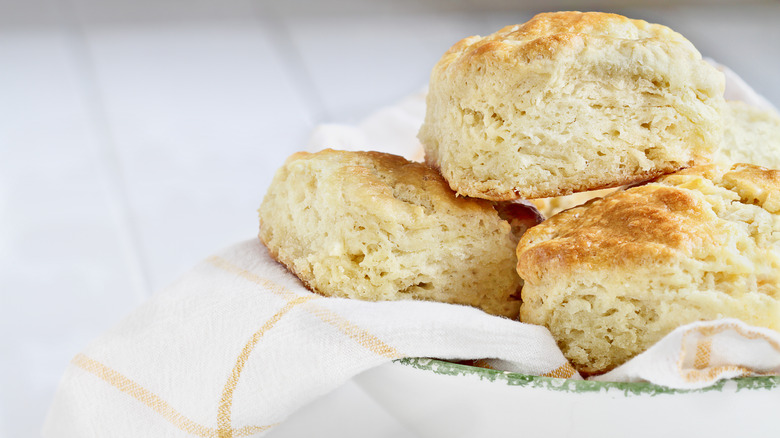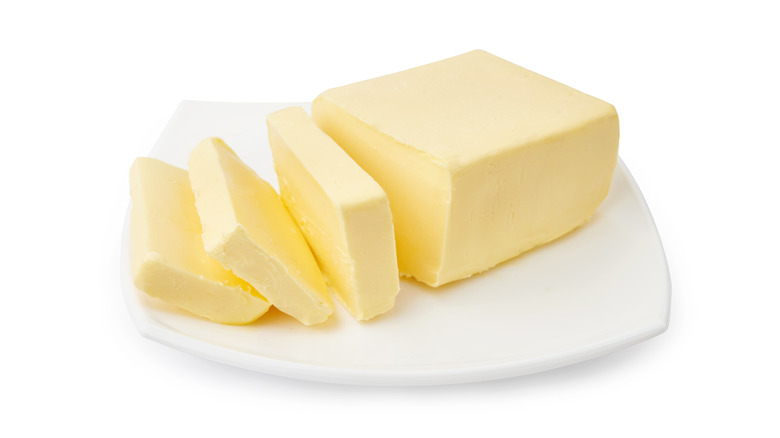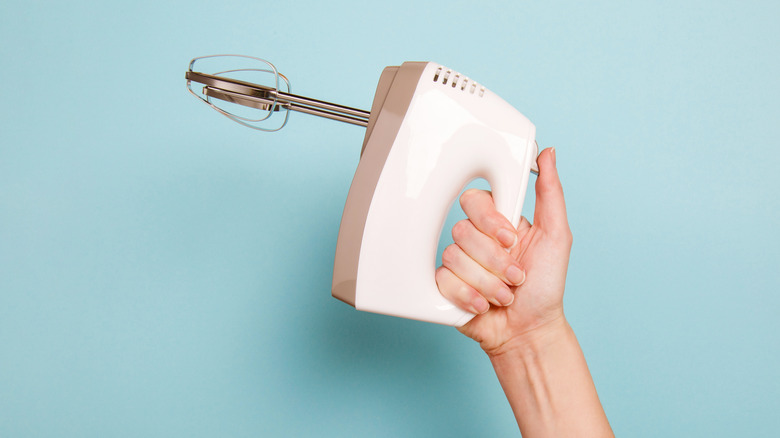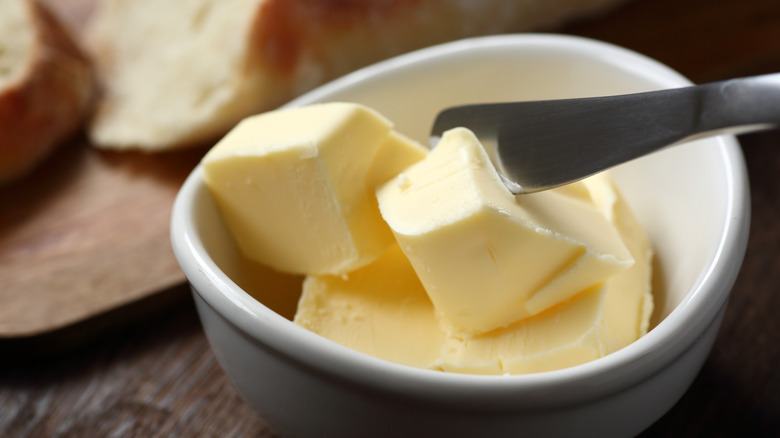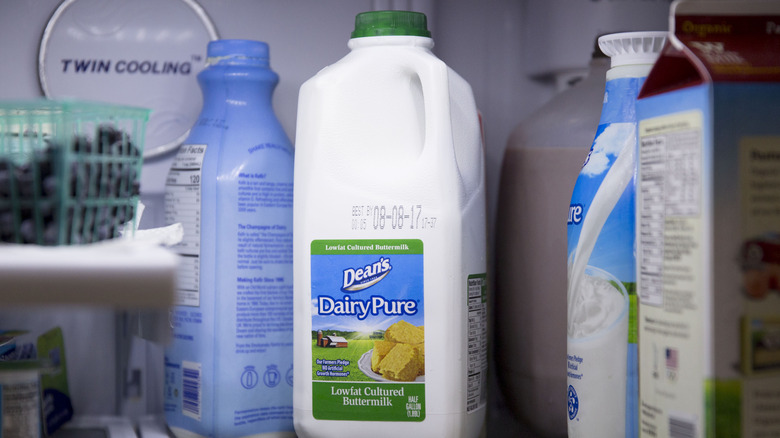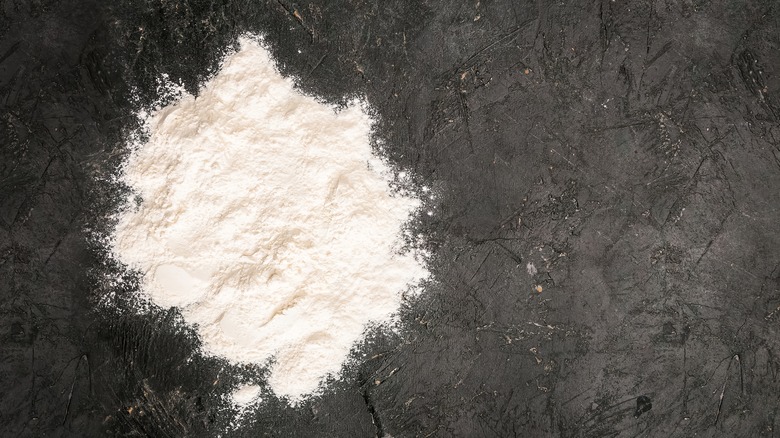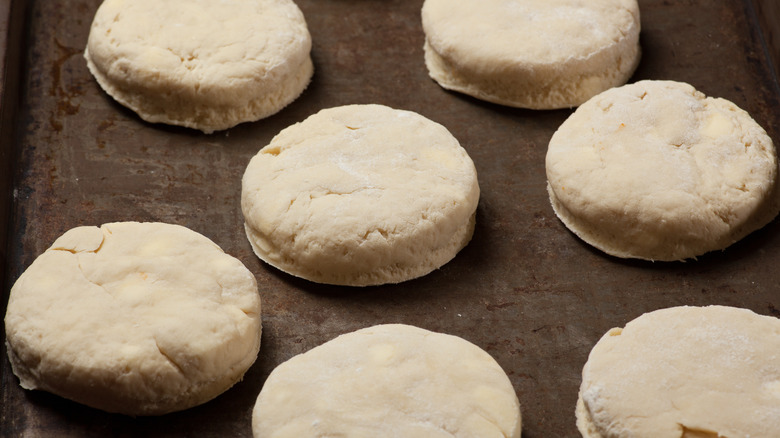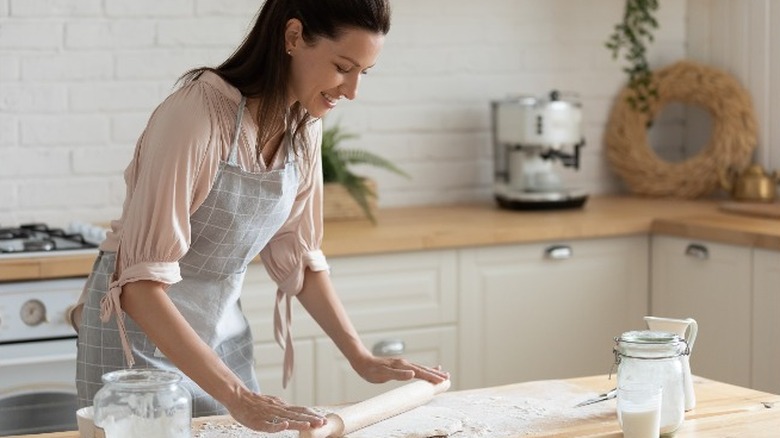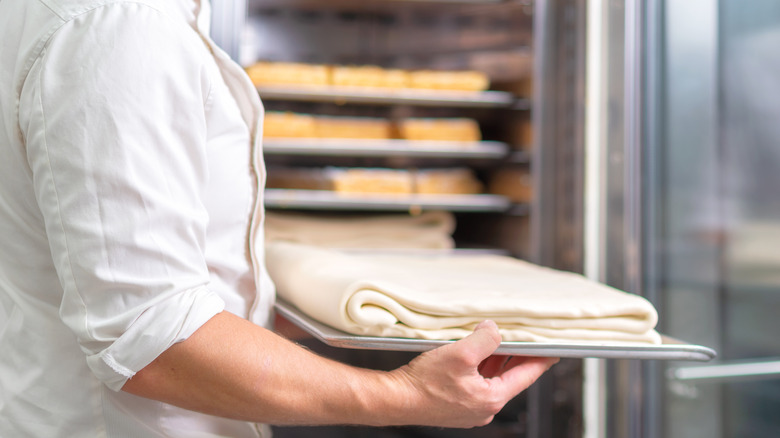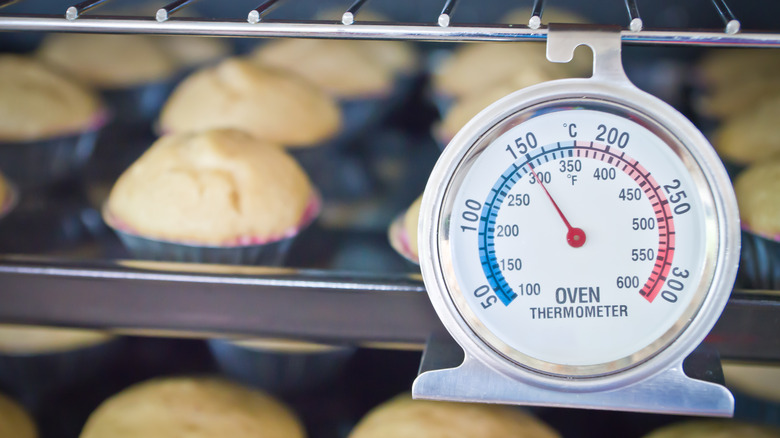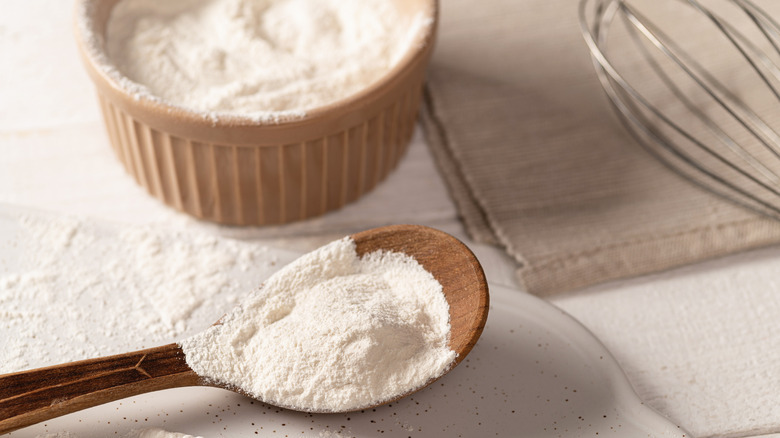Mistakes Everyone Makes When Baking Biscuits
We may receive a commission on purchases made from links.
Imagine a world of fresh biscuits hot from the oven. They should be as tall as skyscrapers. You should be able to count the layers of flakey goodness like floors of that skyscraper. Their buttery flavor and soft crumb are complemented — and possibly even outmatched — by their crispy outside that practically dissolves in your mouth as you take a bite.
Now look down at your own homemade biscuits. They may be good, but they're probably not that great. Their rise does not tower; their crumb isn't tender. And overall, they just feel a little lackluster. You wonder what went wrong; you followed the recipe to a tee. But the problem isn't in the recipe. Rather, the problem is in what the recipe didn't tell you. There are mistakes everyone makes when baking biscuits that prevent them from turning out the way they want. With our tips and tricks, we can help your biscuits turn out so good, you will give Chick-Fil-A and Bojangles a run for their money.
Cutting the butter too big
Butter is one of the key ingredients of biscuits. Without it, biscuits would just be dry dough balls begging for some fat. Butter is what helps give pastries height as well as a soft crumb and rich taste. According to butter giant Land O'Lakes, when pieces of cold butter hit the oven, they melt, creating pockets of air that give you those beautiful, flaky layers in a biscuit.
Incorporating cold butter into flour is appropriately called the biscuit method (per Food Above Gold). To accomplish this, butter is added to the flour before any wet ingredients, and then cut into smaller and smaller pieces until the mixture takes on a mealy consistency, and small pieces (about the size of a pea) are visible. It is important to make sure your butter pieces aren't too big. If they are, this can cause problems when the remaining ingredients are incorporated into the flour and butter. This will result in biscuits that are floury and filled with holes where that butter once was (via Fine Cooking).
Cutting the butter too small
Equally as detrimental to cutting the butter too large is cutting the butter too small. Cutting the butter too small can cause two main problems. The first is that you can inadvertently end up overworking the dough and create a tough biscuit (via Land O'Lakes). The other problem is that without those pea-sized chunks of butter, you aren't going to get beautiful, flakey layers. There will be no pockets of butter to melt.
To avoid cutting the butter too small, it is generally suggested to stay away from cooking appliances such as electric mixers. These cream the butter rather than cut it, and that means they have no place in the biscuit world. It is generally considered better to cut in the butter manually, using either a pastry cutter, a fork, or even your hands (per Nellie's Free Range). Food processors can be used, but should be monitored carefully so as not to over-cut the butter.
If you are concerned about the size of your butter chunks, one biscuit-making hack to ensure the perfect size every time is to use a box grater to grate frozen butter right into your flour. This will result in pieces that aren't too big and aren't too small.
Using room temperature butter
While we are on the subject of butter, there is one more thing you should be aware of. Only cold butter should be used when making biscuits. Well-chilled or even frozen butter is ideal. The colder the better, really; now's not the time for room temperature butter.
Using cold butter prevents it from incorporating into the dough before you want it to. Remember how we said that over-mixing can create tough biscuits? Same with using room temperature butter. If the butter isn't cold when it goes into the oven, it won't be able to hold its shape to release those tiny pockets of steam, which give the biscuit those beautiful flakes (via Nellie's Free Range). Instead, your biscuits will likely turn out something closer to a shortbread. Still delicious, but decidedly not a biscuit. To achieve a flaky pastry and crispy top, it should be cold butter all the way.
Not using buttermilk
The South is synonymous with buttermilk biscuits. Buttermilk isn't just there for show; it has a real purpose. It does double duty, both as a leavening agent to raise the roof of your biscuits and as a tenderizer, providing a soft, delicate crumb (via Of Batter and Dough.) According to Taste of Home, the acid in the buttermilk helps soften the gluten, the protein responsible for holding baked goods together. It is this acid that also reacts with baking soda to give more volume and rise.
If you don't have buttermilk on hand, whole milk mixed with some vinegar or lemon juice works well as a substitute. And shockingly, if a bit gimmicky, mayonnaise can work as a secret ingredient in a tender biscuit, acting as both the acid and the fat. If you really don't have anything in your kitchen that could give a kick of acidity, you can try swapping out the baking soda with baking powder, though note that the amount needed will be different.
Using the wrong flour
You may think that bag of generic, all-purpose flour in your pantry will make you good biscuits. Why wouldn't you? It is called "all-purpose," isn't it? Well, the truth of the matter is that while you certainly could use it to make biscuits, it's far from ideal. Time and time again, tests of different brands have shown that while there are a lot of wrong flours, there is only one right flour to use for making biscuits.
Cooking on the Side tested three different flours: Gold-Medal All-Purpose with baking powder and salt added, White Lily self-rising, and a store brand self-rising. Allrecipes took their test one step further, testing six different brands including fan favorites such as Bob's Red Mill and King Arthur. They both came to the conclusion that the answer is White Lily. The biscuits made with this particular brand were soft and light and produced an excellent height. It is no wonder it is the brand of flower used exclusively in Chick-Fil-A's famous biscuits.
The reason comes down to basic science. White Lily is made with low-protein wheat (with a protein content of 11%, according to the company). NPR says a lower protein content prevents too much gluten from forming, keeping the biscuits tender and allowing the leavening agents to work their magic.
Undermixing the dough
You've got all your ingredients together: The butter is chilled and cut appropriately, and you have the best flour for biscuit making. Now it's time to put it all together. Don't mess up your perfect dough by mixing it incorrectly.
First, you want to make sure not to undermix your ingredients. This should be easy enough to catch because if the dough is undermixed, it will be crumbly and likely not hold together. As such, it will be noticeably difficult to roll out. Undermixing doesn't allow the liquid (in this case, buttermilk) to evenly disperse, and it doesn't allow gluten bonds to develop in the pastry. Both of these properties contribute to the dough's ability to maintain its shape (via Baking Kneads). If you notice your dough crumbling and not holding the way it should, try giving it a few more light mixes and see if that improves the texture.
Overmixing the dough
When it comes to mixing, there is absolutely too much of a good thing. According to Food52, overmixing can be just as damaging to biscuit dough as undermixing.
When a dough is overmixed, it can cause too much gluten development, which leads to tough, chewy biscuits. The dough will hold together a little too well, and the end result will not be the pleasant light biscuit that you want. Overmixing can also cause the butter to break down into smaller pieces and incorporate too much with the dough, leading to a whole host of problems detailed above. Neither of these are things we want in our biscuits. In this case, less is absolutely more. When it comes to biscuits, mix the bare minimum you can until all the ingredients are evenly incorporated ... and then stop! Do not pass go, do not collect $200. Your biscuits will thank you.
Cutting your biscuits incorrectly
The way you cut your biscuits has a huge impact on the final result. A lot of people think it is straightforward: You grab your cutter of choice, press and twist, and out pops a perfectly circular biscuit ripe for the oven. Anyone who ever used Play-Doh can do it, right? Wrong.
When cutting biscuits, the first thing you need is a sharp cutting tool. According to King Arthur Baking, a dull cutter is more likely to press and seal edges rather than cut straight through them. This is the same reason it isn't recommended that you use a cup or glass in place of a true cutter. The cup's dull edges will press, not cut. If you don't have a sharp biscuit cutter near you, a sharp knife is a good alternative. Plus: Square biscuits mean more biscuits, with no wasted dough.
When cutting, you also want to ensure the cutter is going straight down and back up again. No twisting! Twisting your cutter, Cook's Info says, will also cause the dough to seal, preventing your biscuits from rising correctly.
Reusing your dough too many times
Look, we know it's tempting. The biscuit dough is cut, but now you have this patchwork of shredded dough. You want to reroll it and make more; no delicious biscuit dough should go to waste. But you must resist the temptation. Rerolling dough more than once or twice can lead to a number of problems. As you roll, the gluten bonds form and tighten, and you could end up with increasingly tough dough with each work of that pin (via The Spruce Eats).
If you are dead-set against throwing any biscuit dough away, and we wouldn't blame you if you were, there are a couple options. The Spruce Eats recommends instead of rolling and cutting, simply shaping biscuits by forming dough balls. If you prefer to cut them with a traditional cutter, The Kitchn recommends freezing any leftover scraps and adding them to soups and stews later down the line as a quick and easy dumpling substitute. You can also just cook those scraps in their misshapen state. They may look funky, but they will taste delicious.
Not chilling your dough
Again, using chilled ingredients when making biscuits is really, really, important. One biscuit-making secret even involves chilling the flour beforehand and doing your best not to touch the dough with your hands, lest they warm up the dough. You can avoid issues like this by doing one simple thing: chilling your dough before baking. According to King Arthur Flour, simply pop your baking sheet with your cut dough into the fridge and let it chill for a bit. This will allow the gluten to relax and give you a softer dough, and it will also give any butter that has softened time to re solidify. It's a win-win!
But wait, if biscuit dough should be refrigerated, does that mean you can freeze it? It sure does! Biscuit dough freezes beautifully. According to Taste of Home, simply place your cut biscuit dough on a baking sheet and freeze. Once the dough is frozen into pucks, put them inside a freezer bag for use later when a hankering for fresh-made biscuits strikes you. When it comes time to bake, you don't even need to thaw them; just put them in the oven and add an additional 5–10 minutes to the suggested baking time.
Setting the oven temperature too low
Biscuits bake best at a higher temperature than a lot of other baked goods. While cookies are generally happy at 350 degrees, biscuits baked at that temperature would likely be floppy and flat. According to Southern Kitchen, biscuits need a high heat (425 degrees minimum, the site says), so that the butter and buttermilk release steam, causing the biscuits to rise. Without that steam, you aren't going to get a tall biscuit.
While we are at it, it is probably a good idea to check the internal temperature of your oven. As Handle the Heat points out, even if your oven is reading a certain temperature, it may still be running low. According to Bon Appétit, oven temperatures can be off by as much as 75 degrees. Luckily, there is an easy way to check on your oven. An inexpensive oven thermometer can help ensure the correct temperature and a perfect bake in your oven every time.
Measuring incorrectly
Measurements seem straightforward, but when it comes to flour, it really isn't. If a recipe calls for a weighted measurement of flour, it is worth investing in a digital kitchen scale in order to get the weight correct. That said, many recipes call for cup measurements of flour. The problem is, if you don't measure your cup correctly, you could end up with way too much flour in your mix. When The Spruce Eats tested flour measuring methods, they found that improperly scooped flour could add up to 20% more flour to a recipe. That is a big difference.
According to Love & Lemons, the best way to measure flour accurately (aside from weighing) is to use a spoon. Fluff your flour using the spoon to get rid of any clumping or density. Then use the spoon to lightly scoop the flour into your measuring cup. Do not press down or pack your flour in any way. When the measuring cup is full, use the flat back of a knife to level off the measuring cup, and you should be left with a perfect cup of flour.
Overthinking it
Is this a bit hypocritical to say after scaring you with an entire article about mistakes you almost certainly have made while baking? Probably. But it's true. Biscuits are incredibly forgiving. If you have ever committed any of these biscuit sins, you likely still ended up with an edible biscuit.
If you have chosen to make your own biscuits rather than buy them, don't get so caught up in doing everything perfectly. Baking is supposed to be a peaceful activity. Delish reports that it is one of the best ways to reduce stress and be mindful. It is a multi-sensory activity that has the power to fully absorb you and bring calm. Plus, practice makes perfect; if they don't turn out the way you hoped the first time, you can always eat this batch and try again later. We are sure you won't have a problem finding any taste testers for your biscuits.
Using an electric mixer
Convenience items are there for just that: convenience. But before you reach for that electric mixer to make biscuits, stop! Using either a stand-up mixer or a handheld mixer is a surefire way to deflate your biscuits.
When making biscuits, we aren't looking to cream the butter as for cookies or cakes. Instead, we want to cut the butter into the dough. When you use an electric mixer like you would when creaming butter and sugar, not only will it warm up the butter, leading to dense results, but the dough is also more likely to become overworked, leading to tough biscuits.
If you would still prefer to cut in the butter using an electric device, reach for the food processor instead. Cook's Illustrated notes that using a food processor can help you achieve a perfectly blended, evenly risen biscuit. First, use the food processors to mix all the dry ingredients. Then add your cold butter into the processor a little at a time, pulsing in between each addition of butter until the dough consists of rough chunks no larger than a pea and are evenly distributed. Finally, remove your dough from the food processor to prevent over-mixing before adding the liquid. And if you don't have a food processor or still insist on making your biscuits by hand? You should still be sure to use cold butter to prevent melting and preserve flakiness!
